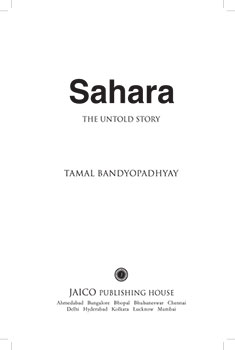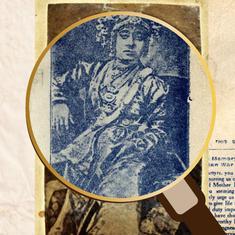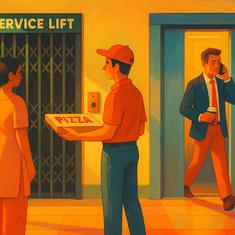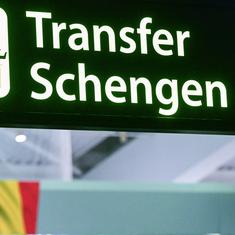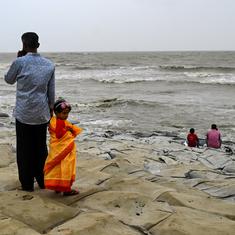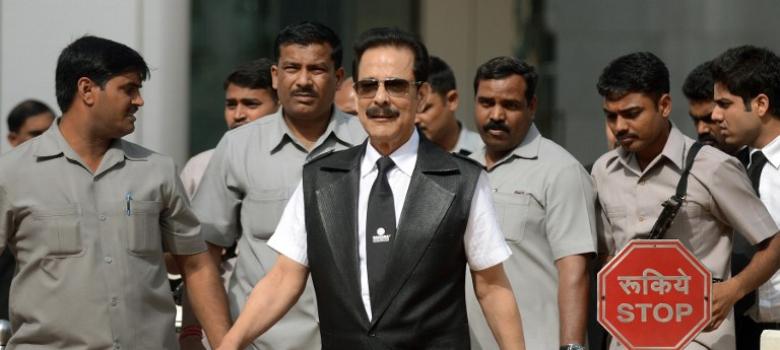On a sweltering May morning in 2013, some 120,000 people were ferried in hundreds of buses hired by Sahara India Pariwar and herded to a large ground on the outskirts of Lucknow. They were on a mission — not theirs — to fulfill one man’s dream of clinching an otiose world record: the largest number of people assembled in one place chorusing a national anthem. In this case, India’s Jana Gana Mana.
Pakistan held the record until then, of 42,813 people singing its anthem:
Pāk sarzamīn shād bād
Kishwar-e-hasīn shād bād
Tū nishān-e-`azm-e-`ālīshān
Arz-e-Pākistān!
Markaz-e-yaqīn shād bād
Early that morning, crowds poured into the 51-acre Ramabai Ambedkar Rally Sthal — large enough for 30 football fields – from the nearby cities of Faizabad, Barabanki and Rae Bareli.
The event began at 10am with Subrata Roy, reverently called Saharasri by his employees, and Subrata Roy Sahara in company handouts, speaking of India’s greatness and his philosophy of “materialism with emotionalism” that had strung his group together against all adversities.
Roy is the managing worker and chairman of the Pariwar, a business conglomerate with 4,799 establishments in its fold and at least ₹1.52 trillion in assets, including a land bank of 36,631 acres along with business interests in real estate, finance, infrastructure, media and entertainment, health care and hospitality, retail, consumer products, information technology, cricket, hockey and Formula One racing.
High on nationalism, Roy addressed the congregation telling them how the blessings of Mother India, the group’s deity, had helped Sahara weather the odds in its journey of 35 years. Then the chorus — Jana-Gana-Mana.
Enthusiasm, and patience, began to wane soon after and the crowd, perspiration dripping, began to fidget. Some tried heading for the nearest exit to the grounds, but the announcer chided them into staying back. “All those heading for the east exit are to immediately return to their places. Do not leave your spot until you are told to. There are cameras all around. The cameras are on you. Come back,” the announcer blared.
Representatives of the Guinness World Records went through the crowd scribbling notes on clipboards as they took count. “Don’t move. The survey officials are still taking a count. Please stay in your places,” said the voice from the loudspeaker. Sahara didn’t want even one warm body missing from the record’s tally. A few hours later, Guinness gave its stamp of approval.
The Ramabai Ambedkar Rally Sthal was one of many places where the singing of the national anthem was staged on 6th May at 10am. In Delhi, the venue was the Indira Gandhi Stadium, the largest indoor sports arena in India which hosted indoor games during the 1982 Asian Games; in Mumbai, it was the Mumbai Metropolitan Region Development Authority grounds at the Bandra Kurla Complex, a venue for most big events in India’s financial capital.
Sahara’s event was meticulously planned and elaborately rehearsed to ensure its success. At meeting rooms of various Sahara offices, the lyrics were displayed on giant screens and all employees sang to the music, karaoke style, at least for a week before D-day. They rehearsed for hours on 6th May as well.
A sea of Sahara staff and agents — the men in the corporate uniform of black trousers, white shirt and a black tie with the Sahara logo, and the women in black-and-red bordered sarees — stood still holding miniature paper-made national flags. As they progressed to the last stanza of the anthem, they raised the flags for each refrain of Jaya He.
They sang the anthem standing at attention, head and eyes locked in a fixed posture, heels together, toes apart — the chin up, chest out, shoulders back and stomach in position. Days before the event, Sahara put out open invites in newspapers to all Indian citizens to stand at attention and sing the anthem wherever they might be — in schools, colleges, offices or even at traffic crossings — at 10am on 6th May, a Monday.
It asked readers to capture videos of their family members, friends, schoolmates or colleagues singing the anthem and upload these on YouTube and social media “for the whole world to witness the emotional integration, national integration of us, Indians.” The Sahara group called the day Bharat Bhawna Diwas 9a day to display Indian emotion0.
Guinness World Records recognized the record the same day. It typically takes four to six weeks for Guinness to officially recognize a feat as a world record. But it also offers a fast-track process that guarantees a response to an application within three days, on payment of $700 or £450. And if someone wants an instant, on-site verification of a record attempt, one can invite a Guinness adjudicator.
To entice record-seekers with instant gratification, Guinness spices up its offering on its website:
“The presence of an official adjudicator will super-charge the profile and PR potential of your record attempt. The immediate verification of [a] record attempt not only means you can walk away with a Guinness World Records certificate but also allows the media to report the new world record straight away.”
Of course, inviting a Guinness judge for instant verification comes at an additional cost. Later that week, the website of Sahara Samay, the group’s Hindi news television channel, claimed that Sahara’s 1.1 million workers (this is similar to Brussels’s population) across 4,512 offices had joined in; as had army regiments in seven Indian states. Double- spread advertisements in national newspapers with photographs of the event in Lucknow, Delhi and Mumbai claimed that more than seven million students and five million people across India had sung the national anthem that day. That puts the total number at 13.1 million. The group also took a Bharat Bhawna Diwas pledge “to free minds from the confines of religion, caste, section and class... To discard negative mindset that rejoices in criticizing others needlessly for sadistic pleasure.”
The entire event was public theatre at its best — a show of strength by a group that many believe is well connected with political parties of all hues. And it was done by a conglomerate that is fighting its toughest, most public and pitched battle with an Indian regulator that has ordered a refund of ₹24,000 crore to 30 million of its depositors.
Roy’s Bharat Bhawna Diwas was an attempt to demonstrate that he was a real nationalist being targeted by vindictive regulators for being a Robin Hood to India’s vast unbanked poor. Only about 35% of India’s adult population is covered under formal banking services according to a World Bank working paper.
Enough is Enough
It wasn’t the first time that Sahara had adopted such tactics to draw public attention. In the third week of March 2013, full-page advertisements splashed across national newspapers in India, screaming “Enough is Enough”. These carried a picture of Mother India, a saree-clad goddess bearing the national flag and riding a chariot drawn by four fierce lions, with the slogan, “Bharat Ma is our strength as a saviour from all evils.”
With this, Sahara challenged the chairman or any senior executive of India’s capital market regulator, the Securities and Exchange Board of India (Sebi), to a 60-minute live television debate with Roy. Through the debate — for which Sahara sought a 10-day notice — the group wanted to “expose the regulator” and the “extreme degree of injustice” it had done in maligning Sahara.
Predictably, Sebi chairman, UK Sinha, did not take up the challenge. In fact, Sinha couldn’t be bothered to meet Roy when the Sahara chief visited the Sebi headquarters in Mumbai’s Bandra Kurla Complex just weeks later in April. Not that Roy visited quietly; he had gone there with three directors of group companies in a convoy of four cars and a small army of bodyguards wielding machine guns. Roy and the three executives had been summoned to present details of their financial holdings and assets in an ongoing dispute related to bond sales to retail investors by two group firms without Sebi’s approval. Prashant Saran, a full-time member of Sebi, met them.
After the hour-long meeting, clad in a half-sleeve white shirt, waistcoat and dark trousers, Roy gave an impromptu speech in Hindi outside Sebi headquarters to the media representatives eagerly waiting for sound bytes. The speech was laced with homilies: “Aaj ek ghanta Sebi ne bithaya humhe. Ummeed thi ki ek pyali chai ke liye poochenge; lekin woh bhi nahi poocha.” (Today, Sebi made us wait for an hour. We had hoped for a cup of tea; we were not offered even that.) He also said, “Is duniya mein kisi sahi aadmi ko galat nahi thehraya ja sakta hai, aur kisi galat aadmi ko sahi nahi.” (Nobody in this world can project an honest person as dishonest or vice-versa.)
Those who were present at the meeting say, Roy was aggressive initially but cooled down when Saran told him that he would have to sign a piece of paper that would record the proceedings of the meeting. Roy and the other directors were asked to list their assets.
Of all the meetings Roy has had with Sebi and the RBI chiefs over the past decade, about his companies accessing public money, whether in the form of deposits or debentures, he would probably best remember his encounter with CB Bhave, Sinha’s predecessor at Sebi. Bhave had put his foot down on clearing the draft red herring prospectus of Sahara Prime City Ltd, which contained information on the group’s massive money-raising activities and did not conform to the norms of the capital market regulator. This snowballed into the biggest-ever crisis for Roy’s empire, which he had built brick by brick over 36 years.
In June 2010, following normal practice, Roy was ushered into a meeting room adjacent to the Sebi chairman’s room on the seventh floor of the headquarters, Sebi Bhawan. Their conversation, according to Sebi insiders, went something like this:
Roy: The Reserve Bank has prejudiced Sebi officers. They are taking a negative view on Sahara’s (initial public offering) application without justification.
Bhave: What’s the issue? They are yet to get the information they had asked for. Where’s the bias? Submit the information. We can have another meeting on this...
Roy: We have taken legal opinion and we are not required to send the information to Sebi. Our regulator is the ministry of corporate affairs. Even former presiding officer of SAT (Securities Appellate Tribunal) Mr. C Achuthan had advised me that you cannot have two regulators like a citizen cannot have two thanas (police stations). As we don’t accept two regulators, we will not give documents. Why don’t you take them from the ministry of corporate affairs like you took information on RNBCs from the RBI?
Bhave: Sebi is not concerned about the legal opinion. Sebi has asked for the information and it needs to be submitted.
Roy: They are voluminous. It’s summer and many of my people have gone on leave. It’s difficult to collate all the information.
Bhave: Let the employees come back from their summer holiday. We will wait.
Roy: If you can clear the application meanwhile...
Bhave: No, no. That can’t happen. We need to scrutinize...
Roy (suddenly standing up): Bus, itna hi? (That’s all?)
Bhave: Maine jitna bola kafi hai... Aur kuch bolu? (I have said enough. Should I say more?)
Roy didn’t utter another word. He stood up, greeted Bhave with folded hands in the gesture of a namaste, and left. The meeting lasted about 15 minutes, over a cup of tea.
When Sinha took over from Bhave at Sebi, he too met Roy at the office. Phone calls from many quarters preceded the meeting where Roy, as was his wont, told Sinha how he had been harassed by the RBI and Sebi so far, and that he would like Sinha to see things in their right perspective.
127 Trucks; 31,000 Metal Trunks
Indeed, the records were voluminous. Almost two-and- a-half years and a protracted legal battle with the market regulator later, on 10th September, 2012, a truck with Uttar Pradesh registration (UP-32-CZ-7837) carried aluminium cartons containing documents to the Sebi office at Bandra Kurla Complex. A second truck that accompanied it carried a Maharashtra number plate (MH-04-CP-2147). These were only two of 127 trucks that would ferry the necessary documents in 31,000 cartons — an unprecedented event in Indian corporate history.
Initially, Sebi did not allow the trucks inside its premises and was unwilling to accept the documents beyond office hours or in installments. The Supreme Court deadline set for supplying the data to Sebi had expired on 10th September.
The Supreme Court had, on 31st August 2012, directed two Sahara companies — Sahara India Real Estate Corp. Ltd and Sahara Housing Investment Corp. Ltd — to refund to investors in three months all the money they had collected by selling optionally fully convertible debentures, or OFCDs, decisively ending a three-year tussle between the regulator and Sahara in favour of Sebi.
India’s highest court had upheld the order of the market regulator and that of its appellate tribunal directing the two firms to refund the money after accusing them of violating regulatory norms by raising money through the debentures from the public in the guise of private placements.
Sahara in a 12th September statement said the documents had been stored in warehouses in Lucknow, the site of Sahara’s headquarters. A few trucks left the city on 7th September carrying the first consignment of papers but they were delayed due to monsoon rains and couldn’t reach the Sebi office in Mumbai before the deadline. Typically, monsoon arrives in most parts of India in June every year and lasts till September.
Via National Highway 3, the distance from Lucknow to Mumbai is a little less than 1,400 km and a vehicle could take up to 23 hours to drive down the stretch, depending on the road and traffic conditions. But a truck takes longer as it can cover at best around 250 km a day.
This was not the sole reason for delay. Assuming that each of Sahara’s 30 million investors (that’s equal to the population of Malaysia) had just one A4 size document each to account for their investments in Sahara’s debentures, the papers stacked up in a pile would be 3,800 metres tall, or 52 times the height of the Qutub Minar, the tallest minaret in India and a world heritage site.
End-to-end, the documents would form a 6,300-km line, twice the distance between the northern and southern ends of the country. And the weight of these documents would be at least 120 tonnes, equivalent to 40 Indian elephants. Sahara said 500 people had been working in three shifts round the clock at its Lucknow warehouse with 20 photo- copying machines. Even then, it would take years to finish making the copies. Sahara also offered the estimate that the exercise would take 275 days if there were 1,500 people and 50 photocopying machines engaged in the work. Incidentally, 202 nations have populations smaller than the total number of investors in Sahara’s optionally fully convertible debentures.
In August 2012, an Internet meme claimed Samsung Corp., upset with losing a patent case to Apple Inc., sent 30 trucks full of 5-cent coins to the iPhone maker to settle a $1 billion fine. Not true, of course. Sahara went several steps ahead and actually sent 127 trucks carrying 31,000 metal trunks of documents to Sebi.
The documents are stored at the office of Stock Holding Corp. of India Ltd House (SHCIL), at Mahape, an industrial area of Navi Mumbai that houses, among others, a huge campus of Reliance Industries Ltd, India’s largest private sector company by revenue. Most offices occupy huge swathes of land and SHCIL, a custodian and depository services firm, is no different: it is one massive building spread across five acres, about 1 km away from the Thane creek hazardous waste disposal facility.
The vast storage space at SHCIL was built to store share certificates. It used to buzz with activity until the mid-1990s, when Sebi introduced dematerialization of shares — for holding securities electronically — after a duplicate share scam hit the Indian market.
With 3.2 million cubic feet in storage capacity, spread over four floors, SHCIL has four bays — each about 12.20 metres high, 100 metres long and 15 metres wide. Through the use of robotics, SHCIL is able to locate any document in just three minutes and deliver it at a client’s office in Mumbai within hours and outside the city in 24 hours.
The facility provides end-to-end solutions for document management — starting with the collection of documents from clients’ offices, to digitization, scanning and condensation so that they occupy minimal space on the server. It also provides password protection and a search engine. This is followed by physical storage of documents, and even destruction of documents at the client’s request.
Each document is stored in a plastic pouch and each pouch is bar-coded and stored in fire-resistant cartons. Air-conditioning increases the shelf life of the papers. Old documents are fumigated before digitization is taken up.
Media reports suggest Sebi had contracted SHCIL for storing, digitizing and scanning investor documents and creating a database, at ₹25.97 crore. Originally, Sebi had floated a tender for the job to choose the lowest bidder, but it was found that the winner was working for the Sahara group. So, Sebi junked the tender and went to SHCIL Projects Ltd, a subsidiary of SCHIL.
SHCIL Projects has about a hundred officers on its rolls and can outsource work for special assignments, like handling the Sahara papers. The area is a high-security zone with biometric systems controlling entry to the place where documents are stored. Even the lifts have different swipe cards to restrict entry.
As one enters the SHCIL office premises from the east gate, the view of the building is backed by hills. The storage unit, at the northern end of the edifice, shares a compound wall with a slum settlement. Four guards man the area 24x7 and a board reminds trespassers that entry is restricted.
Over 100,000 sq ft of storage facility is maintained three floors below ground. For days, at 9:30am, migrant labourers called dehadis unloaded the Sahara cartons from the trucks and took them to the ground floor of the storage unit.
The cartons were sent to the underground facility through conveyor belts where robots arranged them neatly. The scanning room is on the second floor of the building. After the documents were scanned, they were kept in labelled metal trunks, each weighing around 30 kg. Twenty labourers worked day and night for eight days to move the Sahara boxes to the ground floor unit.
The arrival of the Sahara data forced SCHIL to beef up security, even adding two security cameras to the previously existing four. “Danger wala kaam hai. Documents bahut sensitive hai na” (It is a critical assignment as the documents are very sensitive), one of the guards said when the author tried a recce at the facility.
Excerpted with the permission of Jaico Publishing House from Sahara: The Untold Story by Tamal Bandyopadhyay.
We welcome your comments at
letters@scroll.in.
Pakistan held the record until then, of 42,813 people singing its anthem:
Pāk sarzamīn shād bād
Kishwar-e-hasīn shād bād
Tū nishān-e-`azm-e-`ālīshān
Arz-e-Pākistān!
Markaz-e-yaqīn shād bād
Early that morning, crowds poured into the 51-acre Ramabai Ambedkar Rally Sthal — large enough for 30 football fields – from the nearby cities of Faizabad, Barabanki and Rae Bareli.
The event began at 10am with Subrata Roy, reverently called Saharasri by his employees, and Subrata Roy Sahara in company handouts, speaking of India’s greatness and his philosophy of “materialism with emotionalism” that had strung his group together against all adversities.
Roy is the managing worker and chairman of the Pariwar, a business conglomerate with 4,799 establishments in its fold and at least ₹1.52 trillion in assets, including a land bank of 36,631 acres along with business interests in real estate, finance, infrastructure, media and entertainment, health care and hospitality, retail, consumer products, information technology, cricket, hockey and Formula One racing.
High on nationalism, Roy addressed the congregation telling them how the blessings of Mother India, the group’s deity, had helped Sahara weather the odds in its journey of 35 years. Then the chorus — Jana-Gana-Mana.
Enthusiasm, and patience, began to wane soon after and the crowd, perspiration dripping, began to fidget. Some tried heading for the nearest exit to the grounds, but the announcer chided them into staying back. “All those heading for the east exit are to immediately return to their places. Do not leave your spot until you are told to. There are cameras all around. The cameras are on you. Come back,” the announcer blared.
Representatives of the Guinness World Records went through the crowd scribbling notes on clipboards as they took count. “Don’t move. The survey officials are still taking a count. Please stay in your places,” said the voice from the loudspeaker. Sahara didn’t want even one warm body missing from the record’s tally. A few hours later, Guinness gave its stamp of approval.
The Ramabai Ambedkar Rally Sthal was one of many places where the singing of the national anthem was staged on 6th May at 10am. In Delhi, the venue was the Indira Gandhi Stadium, the largest indoor sports arena in India which hosted indoor games during the 1982 Asian Games; in Mumbai, it was the Mumbai Metropolitan Region Development Authority grounds at the Bandra Kurla Complex, a venue for most big events in India’s financial capital.
Sahara’s event was meticulously planned and elaborately rehearsed to ensure its success. At meeting rooms of various Sahara offices, the lyrics were displayed on giant screens and all employees sang to the music, karaoke style, at least for a week before D-day. They rehearsed for hours on 6th May as well.
A sea of Sahara staff and agents — the men in the corporate uniform of black trousers, white shirt and a black tie with the Sahara logo, and the women in black-and-red bordered sarees — stood still holding miniature paper-made national flags. As they progressed to the last stanza of the anthem, they raised the flags for each refrain of Jaya He.
They sang the anthem standing at attention, head and eyes locked in a fixed posture, heels together, toes apart — the chin up, chest out, shoulders back and stomach in position. Days before the event, Sahara put out open invites in newspapers to all Indian citizens to stand at attention and sing the anthem wherever they might be — in schools, colleges, offices or even at traffic crossings — at 10am on 6th May, a Monday.
It asked readers to capture videos of their family members, friends, schoolmates or colleagues singing the anthem and upload these on YouTube and social media “for the whole world to witness the emotional integration, national integration of us, Indians.” The Sahara group called the day Bharat Bhawna Diwas 9a day to display Indian emotion0.
Guinness World Records recognized the record the same day. It typically takes four to six weeks for Guinness to officially recognize a feat as a world record. But it also offers a fast-track process that guarantees a response to an application within three days, on payment of $700 or £450. And if someone wants an instant, on-site verification of a record attempt, one can invite a Guinness adjudicator.
To entice record-seekers with instant gratification, Guinness spices up its offering on its website:
“The presence of an official adjudicator will super-charge the profile and PR potential of your record attempt. The immediate verification of [a] record attempt not only means you can walk away with a Guinness World Records certificate but also allows the media to report the new world record straight away.”
Of course, inviting a Guinness judge for instant verification comes at an additional cost. Later that week, the website of Sahara Samay, the group’s Hindi news television channel, claimed that Sahara’s 1.1 million workers (this is similar to Brussels’s population) across 4,512 offices had joined in; as had army regiments in seven Indian states. Double- spread advertisements in national newspapers with photographs of the event in Lucknow, Delhi and Mumbai claimed that more than seven million students and five million people across India had sung the national anthem that day. That puts the total number at 13.1 million. The group also took a Bharat Bhawna Diwas pledge “to free minds from the confines of religion, caste, section and class... To discard negative mindset that rejoices in criticizing others needlessly for sadistic pleasure.”
The entire event was public theatre at its best — a show of strength by a group that many believe is well connected with political parties of all hues. And it was done by a conglomerate that is fighting its toughest, most public and pitched battle with an Indian regulator that has ordered a refund of ₹24,000 crore to 30 million of its depositors.
Roy’s Bharat Bhawna Diwas was an attempt to demonstrate that he was a real nationalist being targeted by vindictive regulators for being a Robin Hood to India’s vast unbanked poor. Only about 35% of India’s adult population is covered under formal banking services according to a World Bank working paper.
Enough is Enough
It wasn’t the first time that Sahara had adopted such tactics to draw public attention. In the third week of March 2013, full-page advertisements splashed across national newspapers in India, screaming “Enough is Enough”. These carried a picture of Mother India, a saree-clad goddess bearing the national flag and riding a chariot drawn by four fierce lions, with the slogan, “Bharat Ma is our strength as a saviour from all evils.”
With this, Sahara challenged the chairman or any senior executive of India’s capital market regulator, the Securities and Exchange Board of India (Sebi), to a 60-minute live television debate with Roy. Through the debate — for which Sahara sought a 10-day notice — the group wanted to “expose the regulator” and the “extreme degree of injustice” it had done in maligning Sahara.
Predictably, Sebi chairman, UK Sinha, did not take up the challenge. In fact, Sinha couldn’t be bothered to meet Roy when the Sahara chief visited the Sebi headquarters in Mumbai’s Bandra Kurla Complex just weeks later in April. Not that Roy visited quietly; he had gone there with three directors of group companies in a convoy of four cars and a small army of bodyguards wielding machine guns. Roy and the three executives had been summoned to present details of their financial holdings and assets in an ongoing dispute related to bond sales to retail investors by two group firms without Sebi’s approval. Prashant Saran, a full-time member of Sebi, met them.
After the hour-long meeting, clad in a half-sleeve white shirt, waistcoat and dark trousers, Roy gave an impromptu speech in Hindi outside Sebi headquarters to the media representatives eagerly waiting for sound bytes. The speech was laced with homilies: “Aaj ek ghanta Sebi ne bithaya humhe. Ummeed thi ki ek pyali chai ke liye poochenge; lekin woh bhi nahi poocha.” (Today, Sebi made us wait for an hour. We had hoped for a cup of tea; we were not offered even that.) He also said, “Is duniya mein kisi sahi aadmi ko galat nahi thehraya ja sakta hai, aur kisi galat aadmi ko sahi nahi.” (Nobody in this world can project an honest person as dishonest or vice-versa.)
Those who were present at the meeting say, Roy was aggressive initially but cooled down when Saran told him that he would have to sign a piece of paper that would record the proceedings of the meeting. Roy and the other directors were asked to list their assets.
Of all the meetings Roy has had with Sebi and the RBI chiefs over the past decade, about his companies accessing public money, whether in the form of deposits or debentures, he would probably best remember his encounter with CB Bhave, Sinha’s predecessor at Sebi. Bhave had put his foot down on clearing the draft red herring prospectus of Sahara Prime City Ltd, which contained information on the group’s massive money-raising activities and did not conform to the norms of the capital market regulator. This snowballed into the biggest-ever crisis for Roy’s empire, which he had built brick by brick over 36 years.
In June 2010, following normal practice, Roy was ushered into a meeting room adjacent to the Sebi chairman’s room on the seventh floor of the headquarters, Sebi Bhawan. Their conversation, according to Sebi insiders, went something like this:
Roy: The Reserve Bank has prejudiced Sebi officers. They are taking a negative view on Sahara’s (initial public offering) application without justification.
Bhave: What’s the issue? They are yet to get the information they had asked for. Where’s the bias? Submit the information. We can have another meeting on this...
Roy: We have taken legal opinion and we are not required to send the information to Sebi. Our regulator is the ministry of corporate affairs. Even former presiding officer of SAT (Securities Appellate Tribunal) Mr. C Achuthan had advised me that you cannot have two regulators like a citizen cannot have two thanas (police stations). As we don’t accept two regulators, we will not give documents. Why don’t you take them from the ministry of corporate affairs like you took information on RNBCs from the RBI?
Bhave: Sebi is not concerned about the legal opinion. Sebi has asked for the information and it needs to be submitted.
Roy: They are voluminous. It’s summer and many of my people have gone on leave. It’s difficult to collate all the information.
Bhave: Let the employees come back from their summer holiday. We will wait.
Roy: If you can clear the application meanwhile...
Bhave: No, no. That can’t happen. We need to scrutinize...
Roy (suddenly standing up): Bus, itna hi? (That’s all?)
Bhave: Maine jitna bola kafi hai... Aur kuch bolu? (I have said enough. Should I say more?)
Roy didn’t utter another word. He stood up, greeted Bhave with folded hands in the gesture of a namaste, and left. The meeting lasted about 15 minutes, over a cup of tea.
When Sinha took over from Bhave at Sebi, he too met Roy at the office. Phone calls from many quarters preceded the meeting where Roy, as was his wont, told Sinha how he had been harassed by the RBI and Sebi so far, and that he would like Sinha to see things in their right perspective.
127 Trucks; 31,000 Metal Trunks
Indeed, the records were voluminous. Almost two-and- a-half years and a protracted legal battle with the market regulator later, on 10th September, 2012, a truck with Uttar Pradesh registration (UP-32-CZ-7837) carried aluminium cartons containing documents to the Sebi office at Bandra Kurla Complex. A second truck that accompanied it carried a Maharashtra number plate (MH-04-CP-2147). These were only two of 127 trucks that would ferry the necessary documents in 31,000 cartons — an unprecedented event in Indian corporate history.
Initially, Sebi did not allow the trucks inside its premises and was unwilling to accept the documents beyond office hours or in installments. The Supreme Court deadline set for supplying the data to Sebi had expired on 10th September.
The Supreme Court had, on 31st August 2012, directed two Sahara companies — Sahara India Real Estate Corp. Ltd and Sahara Housing Investment Corp. Ltd — to refund to investors in three months all the money they had collected by selling optionally fully convertible debentures, or OFCDs, decisively ending a three-year tussle between the regulator and Sahara in favour of Sebi.
India’s highest court had upheld the order of the market regulator and that of its appellate tribunal directing the two firms to refund the money after accusing them of violating regulatory norms by raising money through the debentures from the public in the guise of private placements.
Sahara in a 12th September statement said the documents had been stored in warehouses in Lucknow, the site of Sahara’s headquarters. A few trucks left the city on 7th September carrying the first consignment of papers but they were delayed due to monsoon rains and couldn’t reach the Sebi office in Mumbai before the deadline. Typically, monsoon arrives in most parts of India in June every year and lasts till September.
Via National Highway 3, the distance from Lucknow to Mumbai is a little less than 1,400 km and a vehicle could take up to 23 hours to drive down the stretch, depending on the road and traffic conditions. But a truck takes longer as it can cover at best around 250 km a day.
This was not the sole reason for delay. Assuming that each of Sahara’s 30 million investors (that’s equal to the population of Malaysia) had just one A4 size document each to account for their investments in Sahara’s debentures, the papers stacked up in a pile would be 3,800 metres tall, or 52 times the height of the Qutub Minar, the tallest minaret in India and a world heritage site.
End-to-end, the documents would form a 6,300-km line, twice the distance between the northern and southern ends of the country. And the weight of these documents would be at least 120 tonnes, equivalent to 40 Indian elephants. Sahara said 500 people had been working in three shifts round the clock at its Lucknow warehouse with 20 photo- copying machines. Even then, it would take years to finish making the copies. Sahara also offered the estimate that the exercise would take 275 days if there were 1,500 people and 50 photocopying machines engaged in the work. Incidentally, 202 nations have populations smaller than the total number of investors in Sahara’s optionally fully convertible debentures.
In August 2012, an Internet meme claimed Samsung Corp., upset with losing a patent case to Apple Inc., sent 30 trucks full of 5-cent coins to the iPhone maker to settle a $1 billion fine. Not true, of course. Sahara went several steps ahead and actually sent 127 trucks carrying 31,000 metal trunks of documents to Sebi.
The documents are stored at the office of Stock Holding Corp. of India Ltd House (SHCIL), at Mahape, an industrial area of Navi Mumbai that houses, among others, a huge campus of Reliance Industries Ltd, India’s largest private sector company by revenue. Most offices occupy huge swathes of land and SHCIL, a custodian and depository services firm, is no different: it is one massive building spread across five acres, about 1 km away from the Thane creek hazardous waste disposal facility.
The vast storage space at SHCIL was built to store share certificates. It used to buzz with activity until the mid-1990s, when Sebi introduced dematerialization of shares — for holding securities electronically — after a duplicate share scam hit the Indian market.
With 3.2 million cubic feet in storage capacity, spread over four floors, SHCIL has four bays — each about 12.20 metres high, 100 metres long and 15 metres wide. Through the use of robotics, SHCIL is able to locate any document in just three minutes and deliver it at a client’s office in Mumbai within hours and outside the city in 24 hours.
The facility provides end-to-end solutions for document management — starting with the collection of documents from clients’ offices, to digitization, scanning and condensation so that they occupy minimal space on the server. It also provides password protection and a search engine. This is followed by physical storage of documents, and even destruction of documents at the client’s request.
Each document is stored in a plastic pouch and each pouch is bar-coded and stored in fire-resistant cartons. Air-conditioning increases the shelf life of the papers. Old documents are fumigated before digitization is taken up.
Media reports suggest Sebi had contracted SHCIL for storing, digitizing and scanning investor documents and creating a database, at ₹25.97 crore. Originally, Sebi had floated a tender for the job to choose the lowest bidder, but it was found that the winner was working for the Sahara group. So, Sebi junked the tender and went to SHCIL Projects Ltd, a subsidiary of SCHIL.
SHCIL Projects has about a hundred officers on its rolls and can outsource work for special assignments, like handling the Sahara papers. The area is a high-security zone with biometric systems controlling entry to the place where documents are stored. Even the lifts have different swipe cards to restrict entry.
As one enters the SHCIL office premises from the east gate, the view of the building is backed by hills. The storage unit, at the northern end of the edifice, shares a compound wall with a slum settlement. Four guards man the area 24x7 and a board reminds trespassers that entry is restricted.
Over 100,000 sq ft of storage facility is maintained three floors below ground. For days, at 9:30am, migrant labourers called dehadis unloaded the Sahara cartons from the trucks and took them to the ground floor of the storage unit.
The cartons were sent to the underground facility through conveyor belts where robots arranged them neatly. The scanning room is on the second floor of the building. After the documents were scanned, they were kept in labelled metal trunks, each weighing around 30 kg. Twenty labourers worked day and night for eight days to move the Sahara boxes to the ground floor unit.
The arrival of the Sahara data forced SCHIL to beef up security, even adding two security cameras to the previously existing four. “Danger wala kaam hai. Documents bahut sensitive hai na” (It is a critical assignment as the documents are very sensitive), one of the guards said when the author tried a recce at the facility.
Excerpted with the permission of Jaico Publishing House from Sahara: The Untold Story by Tamal Bandyopadhyay.
